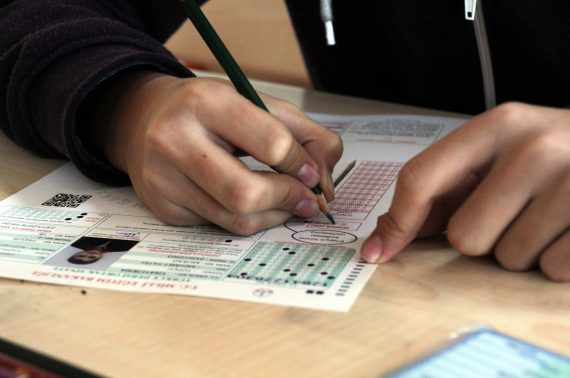Three basic criteria appear as determinants regarding student selection and placement in high schools across the world: GPA, exit examinations and standardized tests. In this framework, the most commonly applied systems include referring students to the schools located in their neighborhood according to their GPA, placements according to their secondary school GPA and exit exam results, and placements based on the results of a standardized test.
In Turkey, standardized tests constitute the main element that determines student placement. Various examination models have so far been implemented in terms of structure, content, modes of application, target groups, score calculation methods, placements systems and so on. As the examination systems of the past 15 years are considered, it is seen that five different systems have been adopted within this period in high school placement. These are respectively the Entrance Examination for High School (LGS), the Secondary Education Institutions Entrance Exam (OKS), the Placement Examination (SBS) that spread out over three years, an updated version of the SBS exam that was implemented only for 8th graders, and finally the Transition from Primary to Secondary Education (TEOG[1]), which has also been implemented for 8th graders.
At the beginning of the 2017-2018 school year, Turkish President Recep Tayyip Erdoğan suggested the removal of TEOG on the grounds that it lays a serious stress and financial burden on students and parents. In order to prepare for the exam, students were heavily attending private courses instead of attending extra-curricular activities provided at their schools. Shortly after Erdoğan’s statement, TEOG was abolished, leading to quests for a new system.
What is TEOG?
TEOG is a standardized test which applied to 8th grade students on six core subjects (Turkish, Mathematics, Science and Technology, Atatürk’s Principles and History of the Turkish Revolution, English, and Religion and Ethics). In addition to the test, the student’s GPA and class attendance were also taken into account in high school placement. The overall placement score was calculated by taking 70 percent of the scores of the standardized tests conducted by the National Education Ministry (MEB) and 30 percent of the student’s GPA.
Representing a new approach to the transition to secondary education, TEOG differs from its previous counterparts in terms of its mode of application and placement type. TEOG is considered a more student-friendly and positive implementation compared to the previous examination systems since it is based on holding a standardized test in each semester of 8th grade. The reason for this is due to the fact that students were able to sit their TEOG exam in their own schools, the content of the tests comply with the curriculum of the semester and in addition, due to class attendance contributing to the final grade, this developed a strong tie between the student and school. More, students were offered the chance to sit a make-up exam, which was an additional benefit. However, these positive traits of TEOG unfortunately do not follow its application when the school placement process begins.
Why was TEOG abolished?
TEOG’s placement system ranks all high schools across Turkey from highest to lowest according to the scores of the students that enroll. For instance, while admission to some high schools required 459 points, some accepted students with a score of 50, which consequences in the labelling of a “successful” and “unsuccessful” school depending on their base point. These labels whether directly or indirectly were affecting the decisions students and parents made when deciding which school to enter. To express more tangibly, students have preferred a school with 300 base points that is located far away from where they live to a school with 250 base points located in their vicinity. Or contrarily, students have had to move away from their neighborhood when their scores only suffice to enter a lower ranking school located away from their home.
Furthermore, by ranking schools in hierarchical order, this system widened the quality gap between schools. While successful students prefer science high schools, less successful ones are obliged to go to theology-focused İmam-Hatip high schools or vocational high schools. As a result, the İmam-Hatip and vocational schools, which used to have a more heterogeneous student profile, started to address solely the weaker students. This sheer difference between the types of schools becomes obvious when international exams and university placements are considered.
Of course, it cannot be asserted that TEOG is the only cause of all these problems. The education system confronts various structural problems that are interrelated. The defects in the examination systems constitute a major part of the problem yet they are not the only reason. Therefore, changing the exam system will not suffice to resolving all the problems. For years, Turkey has been tackling and discussing the issues of quality and equal education. President Erdoğan also occasionally makes self-criticism in that the goals in education could not be achieved. However, in an education system encompassing 18 million students, it is not easy to ensure justice and equality-based stability.
Recommended
In particular, reforming the system by coping with deeply-rooted and long-standing problems is an arduous challenge. Despite that, some quantitative developments have been observed in recent years such as the rises in the budget allocated to education, schooling rates, the number of classrooms and teachers, and the decrease in class quotas. Also, it must be noted that some reformative changes to enable democratization in education were also made during this period. These changes include the abolishment of the headscarf ban and the coefficient system that violated principles of equality and justice, the introduction of the 4+4+4 system and the re-opening of İmam-Hatip secondary schools and the inclusion of religion and culture among elective courses.
Quests for a new system
Following the abolishment of TEOG, while a new examination system is yet to be announced, various scenarios regarding the possible system have taken their place within public discourse. It is known that the MEB has been exerting serious efforts on this subject. As the National Education Minister İsmet Yılmaz stated, several options are currently being evaluated. The first option is introducing a system in which each school will hold individual entrance exams. The second option suggests holding entrance exams only for certain schools while the rest of the schools will admit students based on their place of residence.
The first option does not seem very reasonable in terms of financial costs, logistics and applicability. If a total of 11.000 schools hold separate exams, we will be talking about 11.000 different exams. In such a case, students and parents will have to tour an array of cities to sit for the exams they choose. This option also leads to numerous problems and questions. Who will prepare and evaluate these exams? How will students be placed after the evaluation? How will schools handle the burden of these exams? How will schools cope with the pressure exerted on them by parents, bureaucrats and others, given that these aspects constitute major problems even in standardized systems? Consequently, in current conditions, it does not seem possible for each school to organize its own exam. Also, society has a strong trust in standardized tests. Standardized tests avert the doubts of unequal treatment and have a crucial role in offering important opportunities of vertical transfer although they cannot wipe out socio-economic injustice between students.
As underscored in several previous publications by SETA Foundation, the second option appears as the most reasonable system under present circumstances. Nevertheless, several aspects must be underlined while discussing this system. First of all, the quality of education in different neighborhoods can dramatically differ. With the school rankings shaped by TEOG, this hierarchy has become even stricter in the eyes of people. So, the first thing parents will do is to check the TEOG base points of the school in their place of residence while placing their children. Naturally, they will not wish to send their children to “less successful” schools.
Aside from that, success is not the only variant between schools. Environmental factors such as security in the school’s neighborhood, the socio-cultural structure of the area surrounding the school and typologies of people living in the neighborhood are all important criteria for parents along with the school’s teaching and administrative staff. Therefore, if placements will be based on place of residence, parents must be presented a certain degree of flexibility in order to ease their worries.
A system with several alternatives will relieve both parents and students in this sense. However, a set of distinct criteria must be laid down for the students who wish to enroll in a high school outside of their neighborhood in order to avoid exceeding student quotas and confusions – GPA again plays a major role at this point. Likewise, the quotas of schools that will admit students from other neighborhoods must be determined accordingly, and specific quotas must be allocated to these students. Of course, all these steps are required to maintain transparent.
Another contention regarding this option is the issue of trust in school GPAs, which stirred serious public discussions for some valid reasons. This situation worries both parents and students considering the parents who press on teachers for their children’s grades and the teachers who cannot endure this pressure. Such doubts especially revolve around private schools. However, it is not right to bring all the teachers under suspicion. Teachers receive assessment and evaluation formation and are authorized within this scope, so therefore we have to trust them in principle. The teachers who do not or cannot give fair grades constitute an exception. To resolve this problem, the new system must not be shaped through exceptions, and the MEB is required to implement control mechanisms that would erase doubts and establish trust. Also, any kind of misconduct must be penalized.
In this sense, the MEB is under a heavy burden and is required and expected to develop a new system in line with this responsibility. No preliminary works have evidently been conducted in this respect given the timing of TEOG’s removal. Therefore, this year is likely to become a transition period, where setbacks ought to be expected. Consequently, it is significant for experts, pedagogues, teachers, and other agents within the education system to pay regard to justice and equality and support the MEB in introducing the best system possible.
[1] Initially not being an official abbreviation, TEOG entered the literature due to its common use in public.





